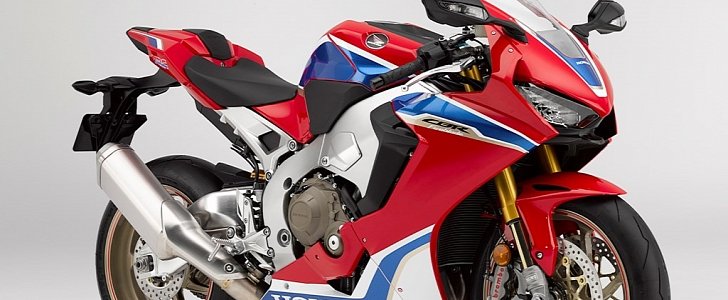Honda’s superbike category gets refreshed for 2017 through the launch of a new CBR1000RR recently unveiled at INTERMOT in Cologne.
The first thing you notice is the new fairing, which has been carefully sculpted to reduce the material in certain areas where it wasn’t necessary as a measure to lower the bike’s weight. The most obvious change can be seen on the sides, where you can now see more of then engine and frame.
Most of the other parts on the bike are new as well, such as the exhaust, brakes, mirrors, seat, switchgear and dashboard. To be precise, Honda said 68 percent of the parts on the bike are new.
The frame went on a diet too, shedding 600 grams by thinning the sidewalls and improving material mass distribution. The swingarm and subframe followed the same recipe along with a rear axle diameter increase to drop 300 g more. Even the rims are 100 g lighter, turning from a 6-spoke Y design to a 5-spoke one.
Moving to the powerplant, the four-cylinder engine retains the same bore and stroke, but its compression raised from 12.3:1 to 13:0, adding 10 hp in the process. The redline has gone up by 750 rpm while the new titanium exhaust system makes the whole assembly 2.8 kg (6.2 lbs) lighter.
Thought the engineers stopped here? Well, 2 kg (4.4 lbs) more have been saved thanks to a new slip-assist clutch system (which also need 17% less pull on the lever to operate) while the lithium-ion battery shaves another kilogram (2.2 lbs).
To top everything off, the 2017 CBR1000RR has a titanium fuel tank. It saves 1.3 kg (2.9 lbs) and sits under the bodywork not to get damaged easily. This makes the new CBR is the first production bike to offer a titanium tank.
Last but not least, the technology deployed in Honda’s top-shelf bike for 2017 is pretty much on the same page with any other motorcycle in its class. This includes an electronically-adjustable Ohlins suspension, fly-by-wire throttle, three-level quick shifter, rear wheel lift control, 6-axis IMU, nine-level traction control, wheelie control, slide control and three-level engine braking.
The user interface is completed by a new high-resolution TFT color display similar on the RCV213-S and the whole bike with all these goodies costs under $20,000, which is quite amazing.
Most of the other parts on the bike are new as well, such as the exhaust, brakes, mirrors, seat, switchgear and dashboard. To be precise, Honda said 68 percent of the parts on the bike are new.
The frame went on a diet too, shedding 600 grams by thinning the sidewalls and improving material mass distribution. The swingarm and subframe followed the same recipe along with a rear axle diameter increase to drop 300 g more. Even the rims are 100 g lighter, turning from a 6-spoke Y design to a 5-spoke one.
Moving to the powerplant, the four-cylinder engine retains the same bore and stroke, but its compression raised from 12.3:1 to 13:0, adding 10 hp in the process. The redline has gone up by 750 rpm while the new titanium exhaust system makes the whole assembly 2.8 kg (6.2 lbs) lighter.
Thought the engineers stopped here? Well, 2 kg (4.4 lbs) more have been saved thanks to a new slip-assist clutch system (which also need 17% less pull on the lever to operate) while the lithium-ion battery shaves another kilogram (2.2 lbs).
To top everything off, the 2017 CBR1000RR has a titanium fuel tank. It saves 1.3 kg (2.9 lbs) and sits under the bodywork not to get damaged easily. This makes the new CBR is the first production bike to offer a titanium tank.
Last but not least, the technology deployed in Honda’s top-shelf bike for 2017 is pretty much on the same page with any other motorcycle in its class. This includes an electronically-adjustable Ohlins suspension, fly-by-wire throttle, three-level quick shifter, rear wheel lift control, 6-axis IMU, nine-level traction control, wheelie control, slide control and three-level engine braking.
The user interface is completed by a new high-resolution TFT color display similar on the RCV213-S and the whole bike with all these goodies costs under $20,000, which is quite amazing.





